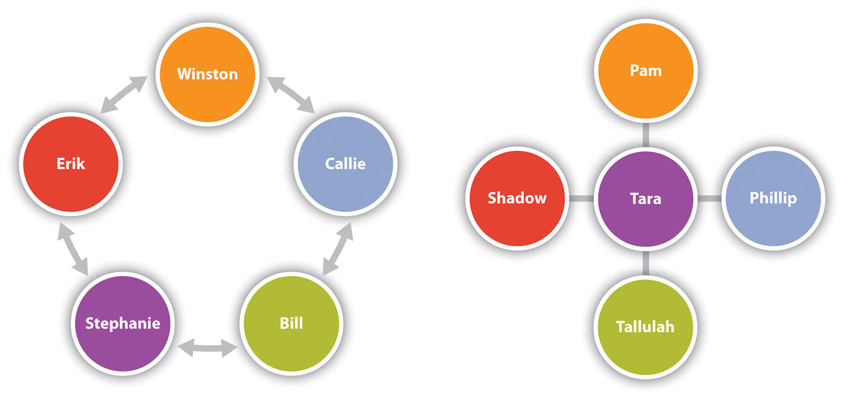1.2 – Characteristics of Small Group Communication

LEARNING OBJECTIVES
- Define small group communication
- Discuss the characteristics of small groups
To begin with, a group can be defined as three or more individuals who organize together towards a shared goal. Consider for a moment the last time you walked down the street. You probably observed many individuals walking in different directions. We would not consider this to be a group of people as each individual has his or her own goal (i.e., to reach a destination, to exercise, to walk a dog, etc.). In contrast, we understand that a group needs to consist of people who organize together towards a shared goal.
Think about your classes this term. Each of the courses in which you are enrolled are examples of different groups to which you belong. For example, your small groups communication course is made up of numerous individuals (i.e., you and your peers) who come together during a specific class time or to a specific online course site for the goal of learning concepts about and enhancing skills of small group communication.
Small groups, then, simple means that we need to consider the size among other attributes. In this section, we will consider the numerous characteristics of small groups.
CHARACTERISTICS OF SMALL GROUPS
Different groups have different characteristics, serve different purposes, and can lead to positive, neutral, or negative experiences. While our interpersonal relationships primarily focus on relationship building, small groups usually focus on some sort of task completion or goal accomplishment. A college learning community focused on math and science, a campaign team for a state senator, and a group of local organic farmers are examples of small groups that would all have a different size, structure, identity, and interaction pattern.
Size of Small Groups
There is no set number of members for the ideal small group. A small group requires a minimum of three people (because two people would be a pair or dyad), but the upper range of group size is contingent on the purpose of the group. When groups grow beyond fifteen to twenty members, it becomes difficult to consider them a small group based on the previous definition. An analysis of the number of unique connections between members of small groups shows that they are deceptively complex. For example, within a six-person group, there are fifteen separate potential dyadic connections, and a twelve-person group would have sixty-six potential dyadic connections (Hargie, 2011). As you can see, when we double the number of group members, we more than double the number of connections, which shows that network connection points in small groups grow exponentially as membership increases. So, while there is no set upper limit on the number of group members, it makes sense that the number of group members should be limited to those necessary to accomplish the goal or serve the purpose of the group. Small groups that add too many members increase the potential for group members to feel overwhelmed or disconnected.
Structure of Small Groups
Internal and external influences affect a group’s structure. In terms of internal influences, member characteristics play a role in initial group formation. For instance, a person who is well informed about the group’s task and/or highly motivated as a group member may emerge as a leader and set into motion internal decision-making processes, such as recruiting new members or assigning group roles, that affect the structure of a group (Ellis & Fisher, 1994). Different members will also gravitate toward different roles within the group and will advocate for certain procedures and courses of action over others. External factors such as group size, task, and resources also affect group structure. Some groups will have more control over these external factors through decision making than others. For example, a commission that is put together by a legislative body to look into ethical violations in athletic organizations will likely have less control over its external factors than a self-created weekly book club.

Group structure is also formed through formal and informal network connections. In terms of formal networks, groups may have clearly defined roles and responsibilities or a hierarchy that shows how members are connected. The group itself may also be a part of an organizational hierarchy that networks the group into a larger organizational structure. This type of formal network is especially important in groups that have to report to external stakeholders. These external stakeholders may influence the group’s formal network, leaving the group little or no control over its structure. Conversely, groups have more control over their informal networks, which are connections among individuals within the group and among group members and people outside of the group that aren’t official. For example, a group member’s friend or relative may be able to secure a space to hold a fundraiser at a discounted rate, which helps the group achieve its task. Both types of networks are important because they may help facilitate information exchange within a group and extend a group’s reach in order to access other resources.
Size and structure also affect communication within a group (Ellis & Fisher, 1994). In terms of size, the more people in a group, the more issues with scheduling and coordination of communication. Remember that time is an important resource in most group interactions and a resource that is usually strained. Structure can increase or decrease the flow of communication. Reachability refers to the way in which one member is or isn’t connected to other group members. For example, the “Circle” group structure in Figure 1 shows that each group member is connected to two other members. This can make coordination easy when only one or two people need to be brought in for a decision. In this case, Erik and Callie are very reachable by Winston, who could easily coordinate with them. However, if Winston needed to coordinate with Bill or Stephanie, he would have to wait on Erik or Callie to reach that person, which could create delays. The circle can be a good structure for groups who are passing along a task and in which each member is expected to progressively build on the others’ work. A group of scholars coauthoring a research paper may work in such a manner, with each person adding to the paper and then passing it on to the next person in the circle. In this case, they can ask the previous person questions and write with the next person’s area of expertise in mind. The “Wheel” group structure in Figure 1 shows an alternative organization pattern. In this structure, Tara is very reachable by all members of the group. This can be a useful structure when Tara is the person with the most expertise in the task or the leader who needs to review and approve work at each step before it is passed along to other group members. But Phillip and Shadow, for example, wouldn’t likely work together without Tara being involved.

Looking at the group structures, we can make some assumptions about the communication that takes place in them. The wheel is an example of a centralized structure, while the circle is decentralized. Research has shown that centralized groups are better than decentralized groups in terms of speed and efficiency (Ellis & Fisher, 1994). But decentralized groups are more effective at solving complex problems. In centralized groups like the wheel, the person with the most connections, person C, is also more likely to be the leader of the group or at least have more status among group members, largely because that person has a broad perspective of what’s going on in the group. The most central person can also act as a gatekeeper. Since this person has access to the most information, which is usually a sign of leadership or status, he or she could consciously decide to limit the flow of information. But in complex tasks, that person could become overwhelmed by the burden of processing and sharing information with all the other group members. The circle structure is more likely to emerge in groups where collaboration is the goal and a specific task and course of action isn’t required under time constraints. While the person who initiated the group or has the most expertise in regards to the task may emerge as a leader in a decentralized group, the equal access to information lessens the hierarchy and potential for gatekeeping that is present in the more centralized groups.
Interdependence
Small groups exhibit interdependence meaning they share a common purpose and a common fate. If the actions of one or two group members lead to a group deviating from or not achieving their purpose, then all members of the group are affected. Conversely, if the actions of only a few of the group members lead to success, then all members of the group benefit. This is a major contributor to many college students’ dislike of group assignments, because they feel a loss of control and independence that they have when they complete an assignment alone. This concern is valid in that their grades might suffer because of the negative actions of someone else or their hard work may go to benefit the group member who just skated by. Group meeting attendance is a clear example of the interdependent nature of group interaction. Many of us have arrived at a group meeting only to find half of the members present. In some cases, the group members who show up have to leave and reschedule because they can’t accomplish their task without the other members present. Group members who attend meetings but withdraw or don’t participate can also derail group progress. Although it can be frustrating to have your job, grade, or reputation partially dependent on the actions of others, the interdependent nature of groups can also lead to higher-quality performance and output, especially when group members are accountable for their actions.
Shared Identity
The shared identity of a group manifests in several ways. Groups may have official charters or mission and vision statements that lay out the identity of a group. For example, the Girl Scout mission states that “Girl Scouting builds girls of courage, confidence, and character, who make the world a better place” (Girl Scouts, 2012). The mission for this large organization influences the identities of the thousands of small groups called troops. Group identity is often formed around a shared goal and/or previous accomplishments, which adds dynamism to the group as it looks toward the future and back on the past to inform its present. Shared identity can also be exhibited through group names, slogans, songs, handshakes, clothing, or other symbols. At a family reunion, for example, matching t-shirts specially made for the occasion, dishes made from recipes passed down from generation to generation, and shared stories of family members that have passed away help establish a shared identity and social reality.
A key element of the formation of a shared identity within a group is the establishment of the in-group as opposed to the out-group. The degree to which members share in the in-group identity varies from person to person and group to group. Even within a family, some members may not attend a reunion or get as excited about the matching t-shirts as others. Shared identity also emerges as groups become cohesive, meaning they identify with and like the group’s task and other group members. The presence of cohesion and a shared identity leads to a building of trust, which can also positively influence productivity and members’ satisfaction.
EXERCISES – Characteristics of Small Groups
- Consider a time when you had to work on a team, either in a personal group, work group, or perhaps on internship in your program. What from your experience might be evidence that you and your teammates reached a level of interdependence?
- With the team experience in mind, what evidence was there that there was a shared identity? How did your group’s cohesion affect the formation of that shared identity?
KEY TAKEAWAY
It is important to understand the characteristics of small groups in order to understand how they function differently from dyads and larger groups.
Media Attributions
- workers
- Private: alexis-brown-omeaHbEFlN4-unsplash
- Group Structures
three or more individuals who organize together towards a shared goal
the way in which one member is or isn't connected to other group members
the degree to which group members share a common purpose and common outcomes
the degree to which members identify with and like the group's task and other group members
